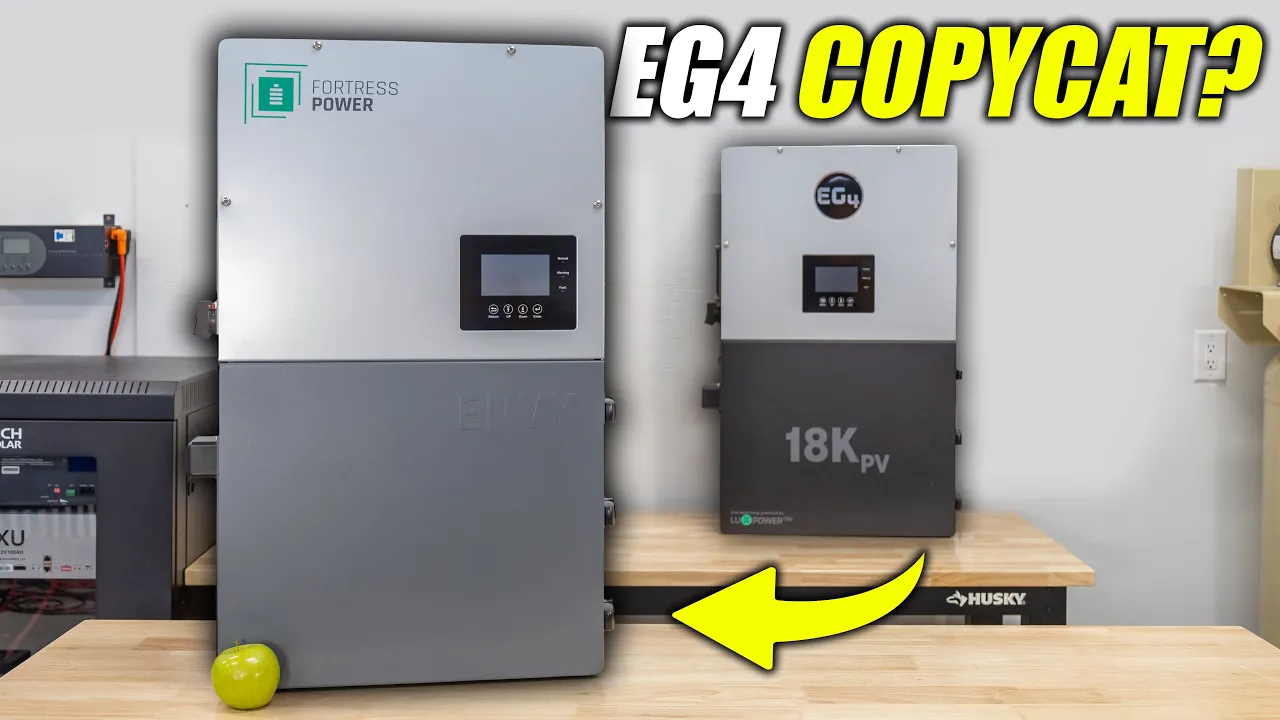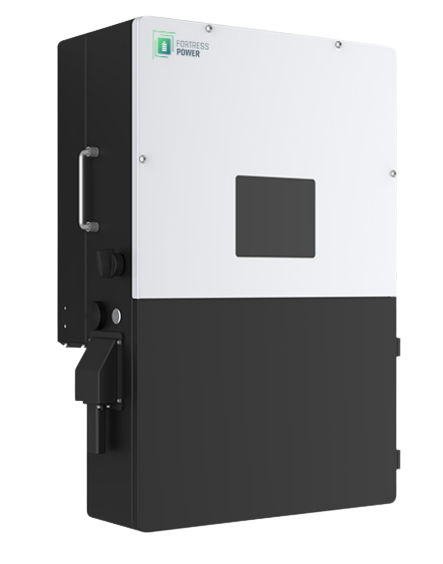

The Fortress Power Envy True 12Kw Inverter is a sleek, weather-rated hybrid inverter with a solid reputation and strong specs, but if you're looking at it and thinking, "Isn't that just an EG4 18KPV with a new paint job?" …you’re not alone.
We thought the same thing.
So, we got our hands on one, put it through full off-grid testing, compared it head-to-head with the EG4 18KPV Inverter, and, unsurprisingly, we found it performed well. But does that mean you should buy it over its EG4 twin?
Let’s find out.
Before diving into performance and experience, here’s a quick spec rundown for this very familiar inverter:
If you're familiar with the EG4 18KPV, all of these specs will sound very familiar. Because, frankly, it’s nearly an identical unit.
{{review-summary}}
When we first unboxed the Envy True 12K, the similarities to the EG4 18KPV were striking. We’re talking the same terminal layout, internal design, identical solar and output specs, and the same hybrid functionality.
Even just from looking at these two units, they pretty much have the exact same physical dimensions and design.
The differences? Pretty minimal:
So, given that these two units barely seem like they have any differences, we reached out to both companies to clarify why someone should buy one unit over the other. Basically, we wanted to see if they even knew if their inverters were different products.
We have plenty of experience dealing with EG4’s customer support, and they’re almost always really helpful, so we weren’t surprised to get a friendly and informative response to our question.
This is what they had to say:
“While both units are very similar when it comes to specs, software and support will be much different with the EG4 and Lux line of products. These items are tailored to exactly what EG4 batteries and other components want, rather than just being programmed with base factory software.”
This gave us our clearest clue: the Fortress inverter is using base software, while the EG4 version has more customization baked into it.
Now, this was really our first time reaching out to this company, so we weren’t really sure what to expect. Fortunately, we were greeted by friendly, American-based support, which is always a huge plus for any solar company. The downside? They weren’t overly helpful.
Basically, their reply was mostly about their E-FORCE ESS battery system, and not the inverter at all. They emphasized battery integration, Guardian monitoring, and seamless pairing with their batteries, which we later found out wasn’t nearly as “seamless” as they claimed.
So, both companies gave some insight, but they failed to offer a solid reason why the Envy would be the better purchase over the EG4 18KPV.
It may sound a little strange to go over the things we like about an inverter that is pretty much identical to a unit we’ve already tested numerous times, but it’s worthwhile. In fact, it’s actually where we started to see a few of the differences between them emerge:
First off, the performance was really solid with this unit, even if that wasn’t overly surprising given how highly we think of the EG4 18K.
In off-grid mode with battery-only input, the unit did everything we asked of it. It delivered 12kW continuous output, passed our off-grid load tests, and the idle consumption was around 80W—slightly higher than the EG4, but still more than acceptable.
Aside from being green-themed, the screen was very similar to what we’ve seen on EG4 inverters. It was responsive, well laid out, and easy to navigate. You rarely need a manual, meaning everything’s where you expect it to be within the display.
One area where the unit differed was the fact that the Envy features pre-threaded weather-sealed knockouts, which means there’s absolutely nowhere for water to get inside the unit. Like the EG4 unit, it has a NEMA 4X weather rating, so it would be a good option for fully outdoor setups.
In addition to those weather-sealed cable knockouts, it also features lockable door latches, a built-in PV isolator, rapid shutdown connection, and built-in breakers. Just like the EG4 18K, the quality is really solid.
We spent over two hours on the phone with Fortress support, and while setup was more complicated than we anticipated, their team was helpful, knowledgeable, and based in the United States.
They weren’t just reading from a manual, and it was clear they knew the hardware inside and out. From our perspective, that really matters.
Just like the 18KPV, there’s a lot we liked about this unit, but it’s not without its flaws. Unfortunately, one of those flaws is actually pretty glaring, especially for your typical DIY installer…
This was one of the most difficult inverters we’ve ever had to configure. While the EG4 18KPV comes pre-programmed for EG4 batteries, the Fortress Envy arrived with no optimized settings, even for its own E-FORCE battery system!
You’ll need not one but two pinout adapters to get the inverter to talk to the Fortress battery, and the process is a headache for DIYers.
We’re pretty experienced with these types of installs, but it took an hour-long support call just to figure out why it was shutting off at 23% SOC despite being set to stay on until 20%.
For first-time users or DIY installers, this is a red flag. Our suspicion, Fortress Envy markets this unit more towards experienced solar installer companies, rather than your typical one-time buyer.
The Envy handled 12kW continuous just fine, but its surge performance was less responsive than the 18K. It couldn’t spike power fast enough to start a large compressor we test these bigger inverters with.
Once our compressor’s running load was over about 7kW, it really struggled. You’ll probably need a soft start or alternate strategy for large inductive loads like compressors you get with those huge AC units.
Like the EG4 18KPV, the Rapid Shutdown takes the full 30 seconds to kick in, which is far from what we would consider rapid.
30 seconds is the code requirement in California, but for us, that’s still too slow. We’d like to see units that shut down instantly when the button is pressed.
At nearly $5,000, it’s slightly more expensive than the EG4 18KPV, despite offering no performance gains and requiring more setup effort.
Meanwhile, even the EG4 18KPV is being outclassed by newer EG4 inverters like the EG4 FlexBOSS 18 Inverter and its bigger brother the FlexBOSS 21. As well as the new EG4 GridBOSS MID, which is designed for hybrid/grid-tie applications.
The FlexBOSS lineup is a serious step forward from both of these units, offering easier installs, more features, and better code compliance. So, the Envy feels stuck in an awkward spot: more expensive than the 18KPV (for no apparent reason), but already behind the competition.
In fact, we even put the EG4 18KPV against the FlexBOSS 21, and found that the new kid on the block is probably the better option for most buyers.
If you're working with an installer who already uses Fortress gear or you're locked into the purchase, don’t stress—it’s a very capable inverter!
Once it’s up and running, it performs almost identically to the EG4 18KPV, which has a strong track record, and we’re huge fans of.
However, for DIY users, this unit is hard to recommend over the EG4 18KPV, or even the newer FlexBOSS lineup, especially considering the higher price and more complicated install you’re going to face with the Fortress Envy unit.
The real standout from this review? Fortress Power’s customer support. If they release a next-gen inverter that matches the FlexBOSS or GridBOSS in performance and usability, we’ll be first in line to test it.
They clearly know their stuff, and that gives us confidence in where they’re headed as a brand.
